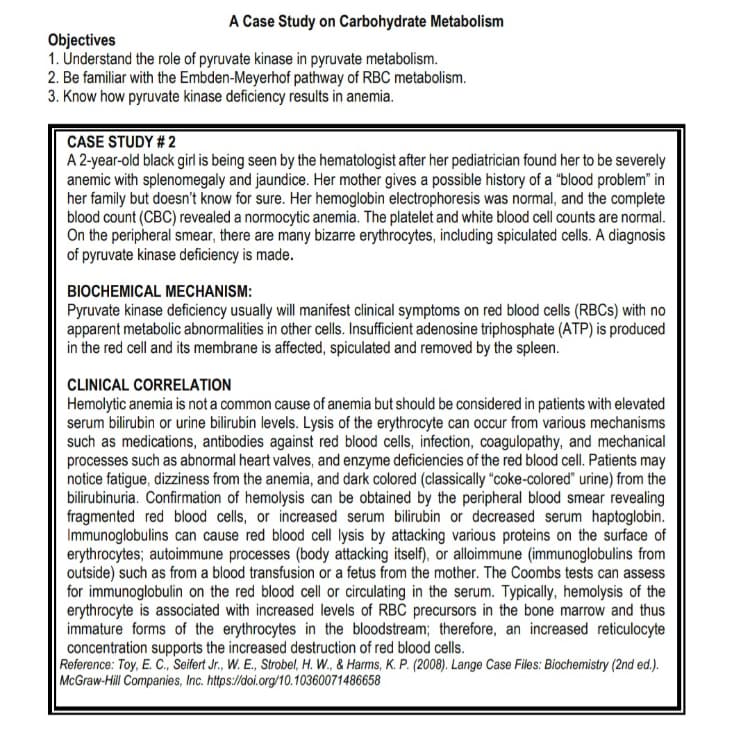How do erythrocytes produce ATP? What is the role of ATP to red-cell morphology and function? 2. How does compromised pyruvate kinase activity lead to anemia?
How do erythrocytes produce ATP? What is the role of ATP to red-cell morphology and function? 2. How does compromised pyruvate kinase activity lead to anemia?
Surgical Tech For Surgical Tech Pos Care
5th Edition
ISBN:9781337648868
Author:Association
Publisher:Association
Chapter11: Hemostasis, Wound Healing, And Wound Closure
Section: Chapter Questions
Problem 2CS
Related questions
Question
The questions are based on the photo below:
1. How do erythrocytes produce ATP? What is the role of ATP to red-cell morphology and function?
2. How does compromised pyruvate kinase activity lead to anemia?

Transcribed Image Text:A Case Study on Carbohydrate Metabolism
Objectives
1. Understand the role of pyruvate kinase in pyruvate metabolism.
2. Be familiar with the Embden-Meyerhof pathway of RBC metabolism.
3. Know how pyruvate kinase deficiency results in anemia.
CASE STUDY # 2
A 2-year-old black girl is being seen by the hematologist after her pediatrician found her to be severely
anemic with splenomegaly and jaundice. Her mother gives a possible history of a "blood problem" in
her family but doesn't know for sure. Her hemoglobin electrophoresis was normal, and the complete
blood count (CBC) revealed a normocytic anemia. The platelet and white blood cell counts are normal.
On the peripheral smear, there are many bizarre erythrocytes, including spiculated cells. A diagnosis
of pyruvate kinase deficiency is made.
BIOCHEMICAL MECHANISM:
Pyruvate kinase deficiency usually will manifest clinical symptoms on red blood cells (RBCS) with no
apparent metabolic abnormalities in other cells. Insufficient adenosine triphosphate (ATP) is produced
in the red cell and its membrane is affected, spiculated and removed by the spleen.
CLINICAL CORRELATION
Hemolytic anemia is not a common cause of anemia but should be considered in patients with elevated
serum bilirubin or urine bilirubin levels. Lysis of the erythrocyte can occur from various mechanisms
such as medications, antibodies against red blood cells, infection, coagulopathy, and mechanical
processes such as abnormal heart valves, and enzyme deficiencies of the red blood cell. Patients may
notice fatigue, dizziness from the anemia, and dark colored (classically "coke-colored" urine) from the
bilirubinuria. Confirmation of hemolysis can be obtained by the peripheral blood smear revealing
fragmented red blood cells, or increased serum bilirubin or decreased serum haptoglobin.
Immunoglobulins can cause red blood cell lysis by attacking various proteins on the surface of
erythrocytes; autoimmune processes (body attacking itself), or alloimmune (immunoglobulins from
outside) such as from a blood transfusion or a fetus from the mother. The Coombs tests can assess
for immunoglobulin on the red blood cell or circulating in the serum. Typically, hemolysis of the
erythrocyte is associated with increased levels of RBC precursors in the bone marrow and thus
immature forms of the erythrocytes in the bloodstream; therefore, an increased reticulocyte
concentration supports the increased destruction of red blood cells.
Reference: Toy, E. C., Seifert r., W. E., Strobel, H. W., & Harms, K. P. (2008). Lange Case Files: Biochemistry (2nd ed.).
McGraw-Hill Companies, Inc. https://doi.org/10.10360071486658
Expert Solution
This question has been solved!
Explore an expertly crafted, step-by-step solution for a thorough understanding of key concepts.
This is a popular solution!
Trending now
This is a popular solution!
Step by step
Solved in 3 steps

Recommended textbooks for you

Surgical Tech For Surgical Tech Pos Care
Health & Nutrition
ISBN:
9781337648868
Author:
Association
Publisher:
Cengage



Surgical Tech For Surgical Tech Pos Care
Health & Nutrition
ISBN:
9781337648868
Author:
Association
Publisher:
Cengage

